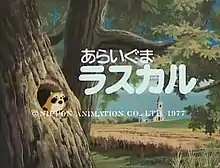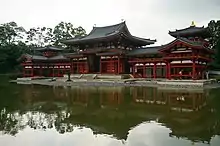| Rascal the Raccoon | |
 Screenshot of the opening logo of Araiguma Rascal | |
| あらいぐまラスカル (Araiguma Rasukaru) | |
|---|---|
| Genre | Drama |
| Anime television series | |
| Directed by | Masaharu Endō Hiroshi Saitō (1-33) Shigeo Koshi (34-52) |
| Produced by | Junzō Nakajima Yoshio Katō |
| Written by | Akira Miyazaki Shōgo Ōta Kasuke Satō |
| Music by | Takeo Watanabe |
| Studio | Nippon Animation |
| Original network | Fuji TV |
| English network | JET TV |
| Original run | 2 January 1977 – 25 December 1977 |
| Episodes | 52 |
Rascal the Raccoon (あらいぐまラスカル, Araiguma Rasukaru, literally Raccoon Rascal, with the Japanese word for raccoon meaning "washing bear") is a 1977 Japanese animated series by Nippon Animation.[1] It is based on the 1963 autobiographical novel Rascal, A Memoir of a Better Era by Sterling North.
In the past, Rascal, the popular fictional raccoon character in a kid's anime, manifested itself as a pet throughout Japan households, leading to the destruction of countless national heritages. In recent years, however, Rascal's popularity has been in steady decline, but some renewed interest has been found in the form of digital stickers and merchandise.[2][3]
Cast
- Masako Nozawa as Rascal
- Toshihiko Utsumi as Sterling North
- Yoshiko Matsuo as Theodora "Theo" North
- Michiru Haga as Jessica North
- Masato Yamanouchi as Willard North
- Kuniko Kashii as Elisabeth North
- Yūji Shikamata as Oscar Sunderland
- Akio Nojima as Carl
- Eken Mine as Federiko
- Hisako Kyouda as Clarissa
- Ichirô Nagai as Thurman
- Kazuko Sugiyama as Sensei
- Masahiko Murase as Conway
- Masako Nozawa as Greta Sunderland
- Masaya Taki as Slammy
- Miina Tominaga as Alice
- Mikio Terashima as Doctor Michel
- Miyoko Asou as Hacket
- Takako Sasuga as Martha
- Takeshi Kuwabara as Arthur
- Tohru Furuya as Tom
- Toshiya Ueda as Futon
Plot
The anime revolves around a young boy who decided to provide shelter to a raccoon that was discovered by a hunter. As the boy attempted to domesticate the wild animal as part of his family, he soon realized through trials and tribulations that his efforts were futile and decided to release Rascal back into the wild.[4]
Music
The series uses two pieces of theme music for the opening theme and the ending theme. The opening theme song is called "Rock River e" (ロックリバーヘ, Rokku Ribâ e, lit. "To Rock River"), and the ending theme is "Oide Rascal" (おいでラスカル, Oide Rasukaru, lit. "Rascal Come"), both sung by the Japanese vocalist by Kumiko Oosugi. The opening theme was later used as the main gameplay theme for the 1981 arcade game Frogger. The show's music was composed by Takeo Watanabe, who worked on many anime of the 1970s and 80s.
Impact

Raccoons are an invasive species in Japan and there is evidence that Rascal the Raccoon has contributed enormously to the problem of invasive raccoons in Japan. Like other invasive species, raccoons in Japan have few natural predators.[5]
Although the anime Rascal the Raccoon's storyline revolves around the difficulties of taking in a raccoon as a pet, Japanese citizens became inspired to import raccoons in to the country as their pet, leading to unforeseen consequences.[4] In Japan, up to 1,500 raccoons were imported as pets each year after the success of Rascal the Raccoon. In 2004, the descendants of discarded or escaped animals lived in 42 of 47 prefectures and then to all 47 prefectures by 2008.[6] These raccoons are now a pest in Japan and imports of raccoons are now banned.
The importation of raccoons was banned because people in Japan started releasing their pet raccoons in to the wild—especially after the final episode of Rascal the Raccoon was released. Additionally, raccoons can become too violent and hard to handle once they grew up, which further encouraged people to release them.[5]
This negatively affected Japan's natural ecosystem and man-made infrastructures and it was estimated that about 80% of the temples in Japan were damaged by raccoons including Byōdō-in in Kyoto which has more than 900 years of history.[4][7] Raccoons attributed to Rascal also caused the destruction of crops in the agricultural sector[4] and Japan suffers an estimated of 30,000,000 yen annually from the effects in the agricultural sector alone.[8]
Even with backlash from animal advocates, the Japanese government decided to adopt the 0% tolerance policy where the goal is to kill as many raccoons as possible. This includes killing thousands of raccoons each year. The government also placed a lot of tight sanctions to minimize the chances of being able to import any more raccoons into the country.[4] In 2003, the Hokkaido government specifically implemented the 10-year plan to completely eradicate raccoons in Japan. However, attempts proved to be mostly futile as there was not enough financial support.[8]
Rascal appearances
Rascal appeared in commercials, games and anime.
- The Adventures of Peter Pan (1989)
- Pokapoka Mori no Rascal (2006, aired in Kids Station as the studio's first anime series for preschoolers.)
- Araiguma Rascal Special in Monster Strike game (game and CM)
- Meitantei Rascal (2014, aired in NHK Educational TV)
- Line, a South Korean Communication Application[2]
Video games
- Araiguma Rascal: Raccoon Rascal, puzzle game developed by J-Force and published by Masaya on 25 March 1994 for the Super Famicom.
- Oide Rascal, action game developed by Agatsuma Entertainment and published by Tam on 25 April 2001 for the Game Boy Color.
References
- ↑ "Araiguma rasukaru" (1977) Archived 2004-06-17 at the Wayback Machine Internet Movie Database (Retrieved 3 October 2009)
- 1 2 "RASCAL – LINE stickers". LINE STORE. Archived from the original on 2019-04-03. Retrieved 2020-10-22.
- ↑ "rascal the raccoon". www.amazon.com. Retrieved 2020-11-05.
- 1 2 3 4 5 Macewan, Matthew (2014-11-21). "Rascal's Secret Plan: the Raccoon Invasion of Japan". Tofugu. Archived from the original on 2020-10-17. Retrieved 2020-10-16.
- 1 2 ZankDigiTrash (January 12, 2013). "Rascal the Raccoon Anime and effects on Japan". Youtube. Archived from the original on 2021-12-17. Retrieved October 24, 2020.
- ↑ 山﨑晃司・佐伯緑・竹内正彦・及川ひろみ (2009). 茨城県でのアライグマの生息動向と今後の管理課題について (PDF). 県自然博物館研究報告 (in Japanese). 12: 41–49. Archived from the original (PDF) on May 29, 2011. Retrieved July 3, 2011.
- ↑ Rascal the Raccoon, archived from the original on 2020-08-05, retrieved 2020-10-16
- 1 2 Ikeda, Tohru; Asano, Makoto; Matoba, Yohei; Abe, Go (December 31, 2004). "Present Status of Invasive Alien Raccoon and its Impact in Japan". Global Environmental Research: 125–231 – via Google Scholar.
External links
- Official website
- Rascal the Raccoon (anime) at Anime News Network's encyclopedia
- Rascal book and anime history site